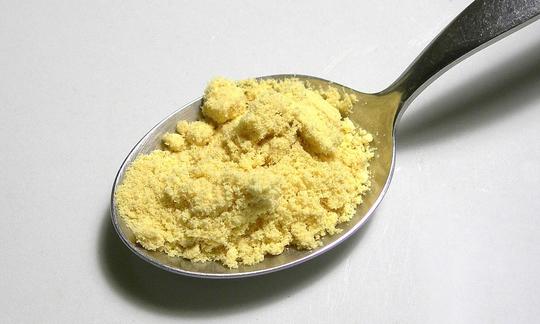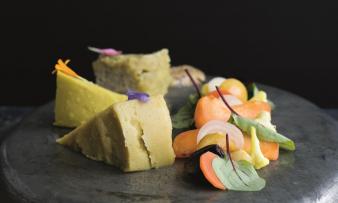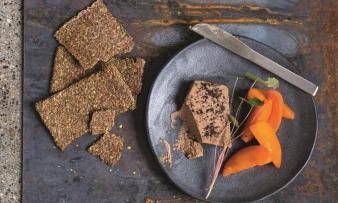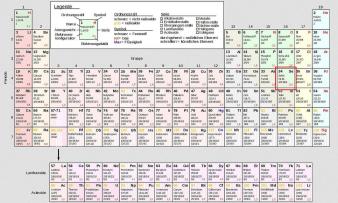Table of contents
What is mustard powder? Organic mustard powder (Semen Sinapis pulveratum) consists of ground mustard seeds ( raw). Depending on the composition, mustard flour is hot (brown or black mustard seeds) or milder, with an 'elegant' spiciness (white mustard seeds).
Use in the kitchen
Mustard powder made from mustard seeds is a digestive and appetite-stimulating spice. It is best to grind it freshly from the whole organic seeds of white ( Sinapis alba), brown ( Brassica juncea) or black mustard ( Brassica nigra), e.g. in a spice mill, pepper mill, coffee grinder, blender or mortar. Whole mustard seeds are tasteless. The sharp aroma is only created by crushing or grinding the seeds and exposing them to liquid. You can find out how the typical mustard taste comes about in the "Further information" chapter below.
Depending on the type of mustard used and other ingredients, you can prepare mild, sweet, spicy, hot or fiery dishes from the raw powder. The white mustard seeds are mild. The brown ones are slightly spicy and the black mustard seeds are very spicy. Mixtures are also popular.
Mustard flour is mainly used in French, English or Asian cuisine. A dish that is too spicy due to mustard can be softened with a vegan cream substitute. As a spice, a pinch of mustard powder - similar topepper - can be cooked into dishes or sprinkled over the finished dish. Mustard flour gives sauces, soups, salad dressings, marinades, dips, stews, raw cucumbers as well as vegan remoulade and mayonnaise (based on cold-pressed rapeseed oil) a mild flavor. The special extra: mustard oils have emulsifying properties.
Mustard powder is a component of homemade curry powder and is used to make Dijon mustard and other mustard preparations. What is mustard made of? You can find a recipe for coarse-grained mustard HERE. A simple mustard paste is made from mustard flour and a little room-temperature drinking water. After letting it steep for a short time (approx. 10-15 minutes), you can add the paste to dishes, use it as a table seasoning and raw dip, or store it in a jar in the refrigerator.
Good to know: If you mix the powder with cold water, the mustard's spiciness develops after a few minutes due to an enzymatic reaction. If you use vinegar, salt or hot water, you get a milder and slightly bitter result.
To pickle vegetables, use whole mustard seeds instead of mustard powder.
Since seed flour contains highly irritating essential oils, it is not suitable for making tea. 1,2
Making your own mustard powder
You can make fresh mustard flour from raw seeds without much effort. Mechanical or electric mortars, coffee, poppy or spice mills and blenders are all suitable tools. With electrically operated devices, make sure they only run for a few seconds. The seeds should not be exposed to too much heat so that the aroma is preserved as best as possible. Because of volatile mustard oils, it is advisable to process the powder immediately or store it in an airtight, dark glass jar. To intensify the color, you can add turmeric powder.
Vegan mustard powder recipe for grilled vegetable marinade
Ingredients (for 2 portions of marinade): 20 g freshly ground organic mustard flour, 20 g apple cider vinegar (5% acid), 2 tbsp tomato paste, 2 tbsp liquid honey, 1 freshly squeezed garlic clove, fresh zest of half an organic lemon, ¼ tsp sweet paprika powder, ¼ tsp turmeric, ¼ tsp dried rosemary, ¼ tsp dried marjoram, black pepper, salt and drinking water as needed.
Preparation: Mix all ingredients together and leave to swell for about 30 minutes. Add a little water if necessary. Now mix half of the marinade with diced grilled vegetables. Suitable vegetables are sweet peppers, eggplant, zucchini, asparagus, tomatoes, cauliflower, broccoli, leeks, mushrooms, etc. Put the marinated vegetables in a grill pan and cook gently.
Alternatively, you can wrap the raw vegetables in portions in chard or beetroot leaves and close them with kebab skewers. Brush the packets sparingly with HOLL rapeseed oil so that they don't burn.
Vegan wholefood recipes with mustard powder can be found under the note: " Recipes that have the most of this ingredient ".
| Not only vegans or vegetarians should read this: Vegans often eat unhealthily. Avoidable nutritional errors. |
Purchasing - Storage
Mustard flour is in season all year round. You can buy it in large, well-stocked supermarkets ( Interspar, Rewe), Asian shops, delicatessens, pharmacies, spice shops, organic shops (possibly Denn's Biomarkt or Alnatura), health food stores, online shops or at spice stands at Christmas markets in conventional or organic quality. According to our internet research, Coop, Migros, Denner, Volg, Spar, Aldi, Lidl, Edeka, Hofer or Billa do not have mustard powder (flour) in their standard range. Pharmacies sell defatted mustard powder (Semen Sinapis pulveratum exoleatum), which is a press residue during the production process of cooking oil.
Some of the grocery stores mentioned sell white (yellow) or brown mustard seeds in various packages up to 1 kg, some of them in raw quality. To preserve the flavors as best as possible, it is advisable to buy whole seeds. Black mustard seeds can be found in delicatessens or online.
Storage tips
Mustard powder should be stored in a dry, dark place. Due to exposure to light and oxygen, freshly ground mustard and opened mustard packets lose their taste, spiciness and aroma after a few months. This does not make the spice bad, it is just that the spiciness decreases. Mustard flour in sealed aroma-protecting spice bags can be stored for one to two years.
Due to the high oil content of polyunsaturated fatty acids, the powder can develop a rancid smell if stored improperly. In this case, it should be disposed of.
Ingredients - Nutritional values - Calories
Here we realistically show you the ingredients of spices and herbs per 1 g (instead of per 100 g as usual).
1 g of mustard powder from Sinapis alba has a calorie content of 5.08 kcal. The main nutrients are 0.36 g fats, 0.28 g carbohydrates (including fiber) and 0.26 g proteins. 3
With 2.08 µg of selenium, 1 g covers almost 4% of the daily requirement. Other selenium-rich vegan foods that are consumed in greater quantities are raw wheat germ (0.79 µg/1g), couscous (0.66 µg/1g) or sesame (0.34 µg/1g). The Brazil nut is one of the plant foods richest in selenium, with 19.17 µg/1g. (To avoid the negative consequences of an overdose, Brazil nuts should only be consumed sparingly. Approx. 3 g covers the entire daily requirement of selenium.) 3
The alpha-linolenic acid content is 0.04 g/1g, which covers about 2% of the daily requirement. Good sources of alpha-linolenic acid (i.e. Omega-3 as ALA) are linseed (0.23 g/1g), chia seeds (0.18 g/1g), walnuts (0.09 g/1g) or hemp seeds (0.09 g/1g). 3
Tryptophan occurs at 0.003 g per 1 g, cocoa powder (0.003 g/1g) or raw pistachios (0.003 g/1g) contain similar amounts of this amino acid. Hemp seeds (0.006 g/1g) andpumpkin seeds (0.006 g/1g) have about twice as much. 3
The mustard oil glycosides (glucosinolates) are among the particularly characteristic ingredients of mustard seeds. While the flour from the black and brown seeds mainly contains sinigrin, the yellow seeds mainly contain sinalbin. 1,4 During grinding, the glucosinolates come into contact with the plant's own enzyme myrosinase, which is stored in separate cells. The glucosinolates are then chemically rearranged to form the mustard oils, which have a sharp taste and irritate mucous membranes. Sinalbin produces a sharp-tasting, non-volatile oil, and sinigrin produces a sharp-tasting, volatile allyl mustard oil. 5
Mustard contains high amounts of undesirable erucic acid. 2,6,7 In a few countries, cultivated forms of Brassica juncea are grown with a lower proportion of the harmful fatty acid. 6
Further components of the mustard composition can be found in the specific mustard seed descriptions.
The complete ingredients of mustard powder, the coverage of the daily requirement and comparison values with other ingredients can be found in our nutrient tables. In the article Nutrients explained you will get a detailed insight into the topic.
Effects on health
Is mustard healthy or unhealthy? Mustard is an appetite-stimulating and digestive spice because it stimulates saliva and gastric juices. 4 Eating a spoonful of mustard every day can therefore have benefits. When used as a spice and if there are no contraindications, mustard is definitely beneficial to health. Too high a quantity, eg in the form of cooking mustard oil or through incorrect preparation, eg as a tea, can have negative effects.
How do the ingredients in mustard affect your health? The glucosinolates sinigrin ( brown and black mustard seeds) and sinalbin ( white mustard seeds) are among the main active ingredients in mustard. When ground, chewed, crushed or made into a paste, they react enzymatically to form essential oils that taste pungent and have health benefits.
External applications are based on the circulation-stimulating, skin-irritating, anti-inflammatory and analgesic properties of the seeds. In various studies, they show anti-cancer, antimicrobial and antioxidant effects. You can find more detailed information with sources in our texts on the individual mustards.
Dangers - Intolerances - Side effects
Mustard flour should not be used on children under 6 years of age, those with kidney disease, severe circulatory damage, varicose veins and other venous diseases. Undesirable side effects of excessive use (> 2 weeks) can include skin and nerve damage and irritation of the renal epithelium. Mustard compresses or plasters that remain on the body part to be treated for too long can cause blistering, which is often accompanied by poorly healing necrosis and ulceration. Particular caution is required for sensitive, predisposed patients. 1,8 Mustard applications should be avoided during pregnancy and breastfeeding. 5
Mustard flour is one of the foods richest in erucic acid. 6 Possible consequences of high intake are fatty heart disease and pathological changes in the heart muscle. 2
Use as a recognized medicinal plant
Black, brown and white mustard have not been processed by the HMPC ( Committee for Herbal Medicinal Products) and are currently not approved or registered medicinal plants according to Section 25 Paragraph 7 of the AMG. Accordingly, there are no approved or traditionally registered finished medicinal products on the market. There are also no monographs for the species mentioned by ESCOP ( Association of National European Societies for Phytotherapy) or Commission E ( Expert Commission for Herbal Medicinal Products), with the exception of yellow mustard.
Folk medicine - naturopathy
In 1990, after assessing the benefit-risk ratio, Commission E produced a so-called positive monograph for Sinapis alba, based on scientific evidence. 5 Indications for treatment with poultices are catarrh of the respiratory tract, chronic degenerative joint diseases and soft tissue rheumatism. In traditional medicine, the seeds are also used for neuralgia. 8
In folk medicine, mustard flour is used exclusively externally, e.g. in the form of poultices (wraps). To do this, mix 4 tablespoons of the powder with warm water to form a paste immediately before use. 8 The water must not be hot or the temperature must not be higher than 60 °C, otherwise the myrosinase will be inactivated. 1 The daily dose is 60-240 g of the seeds. 8
Because of the irritating mustard oil, it is recommended to apply a fatty ointment before treatment. Depending on the sensitivity of the skin, the compresses are applied for 3-5 minutes (max. 10 minutes) for children and 5-10 minutes (max. 15 minutes) for adults. After the first 3 minutes, check for reddening of the skin and for the increase in skin temperature. If there is a strong burning sensation, remove the compress and clean the skin. The compresses, popularly known as mustard compresses, can be used up to four times a day for a maximum period of two weeks. 1,8,9,10 Eyes and face must be protected from the irritating mustard oils. 5
Wrap sets are available from pharmacies. Alternatively, you can use napkins, towels, handkerchiefs, kitchen towels or scarves made of wool, cotton or linen. The pasty mustard mixture is spread on a thin cloth and placed directly on the skin. A second layer of cotton ensures that the wrap is evenly moist and warm. To retain the heat as best as possible, you can wrap the whole thing with a wool scarf.
As an alternative to the wrap, you can buy ready-made mustard plasters and apply them according to the instructions on the package. 1
Another tried and tested option is the mustard flour foot bath. To prepare, add 2 tablespoons of mustard flour to a foot bath with water at around 40°C. The water can reach above the ankles. The bath lasts around 10-20 minutes. Afterwards, the feet must be rinsed thoroughly with lukewarm water. Useful combinations with other phytopharmaceuticals are not yet known. The maximum duration of use is two weeks. 8
Ecological footprint - animal welfare
The CO 2 footprint of mustard flour depends on several aspects, including the ecological balance of the mustard seeds used, but also the processing method, transport and packaging. Despite extensive research, we were unable to find any precise figures on the ecological footprint of mustard flour. There are also no specific figures on the amount of water required to produce 1 kg of mustard flour. 2809 liters of water are needed to produce 1 kg of mustard seeds, and the amount of water required to produce mustard flour is probably slightly higher due to the additional processing steps. 16
The mustard plant is susceptible to a variety of pests that can cause crop losses. To prevent this, pesticides and herbicides are often used in conventional agriculture, but residues from these can also be detected in the end product. 17 Ideally, when shopping, you should look for products that have been organically grown, as the use of synthetic pesticides is prohibited here.
Worldwide occurrence - cultivation
Mustard seeds and mustard powder have been used as a spice and medicinal product for thousands of years. During the Roman Empire, mustard probably reached Central Europe, from where it spread to the rest of Europe. 13
Around 532,769 tonnes of mustard seeds were produced worldwide in 2021. The main growing areas were Nepal (220,250 tonnes), Russia (144,593 tonnes) and Canada (60,532 tonnes). 14
Industrial production
In companies, coarse mustard flour is produced from peeled or unpeeled mustard seeds on a roller mill. The plant species used are Brassica nigra, Brassica juncea or Sinapis alba or mixtures of these seeds. Two rollers running against each other tear the seeds apart. In the next step, the mustard meal is optionally deoiled or partially deoiled to a residual fat content of at least 12 g/100g or it is processed directly with grinders to make fine mustard flour.
For artisanal and industrial processing companies, the grist is the starting product for the production of mustard preparations. The mash, which is mixed with other ingredients, is only put under the millstone or into grinders after fermentation.
Further information
According to the European assessment criteria for food mustard, the Code of Practice, a distinction was previously made between mustard flour and mustard powder. The former (mustard flour) was categorised as a powdered product obtained from peeled and non-deoiled seeds. The latter (mustard powder) corresponded to mustard flour with an addition of a maximum of 20% by weight of spices, herbs or cereal flours. 11 The version updated in 2015 no longer provides for these distinctions. 12
Whole mustard seeds have no taste. The typical mustard taste and its spiciness can only be perceived when mechanical processes bring the corresponding enzymes (myrosinases) together with their substrates (mustard oil glycosides). In the intact plant, these are spatially separated from one another. If the cell walls are destroyed during preparation or chewing, e.g. by humans or natural predators of the plant, the enzymes and substrates come into contact with one another. This causes a chemical reaction which is accelerated by the presence of water (e.g. in the saliva of predators). The myrosinases break down the mustard oil glycosides into glucose (dextrose) and mustard oils. The latter are substances that have the typical sharp and biting taste which in nature deters predators and thus protects the plant from damage. 6 We use this effect to achieve the desired taste in mustard products such as table mustard. In addition to water, liquids such as vinegar, milk, wine or beer are also used to enhance the taste and smell. 15
Alternative names
Fine mustard flour is called mustard powder (incorrectly: mustard powder), coarse mustard flour is called mustard meal. In English it is called mustard powder, dry mustard, mustard flour or flour of mustard. Russian names are горчичный порошок, горчица из порошка or горчица порошок. For information about the mustard powder composition (горчичный порошок: состав) so
Keywords for mustard powder use
Mustard powder is used as a broad-spectrum pesticide against insects, fungi and nematodes. 6
Bibliography - 17 Sources (Link to the evidence)
| 1. | Blaschek W. (Herausgeber). Wichtl - Teedrogen und Phytopharmaka. Ein Handbuch für die Praxis. Stuttgart: Wissenschaftliche Verlagsgesellschaft mbH; 6. Auflage. 2016. |
| 2. | Krist S. Lexikon der pflanzlichen Fette und Öle. Wien: Springer Vienna; 2. Auflage. 2013. |
| 3. | USDA United States Deparment of Agriculture. |
| 4. | Thomas J, Kuruvilla KM, Hrideek TK. Mustard. In: Handbook of Herbs and Spices. Elsevier; 2012:388-398. |
| 5. | Arzneipflanzenlexikon info: Senf. |
| 6. | Lietzow J. Biologically active compounds in mustard seeds: a toxicological perspective. Foods. 2021;10(9):2089. |
| 7. | Boscaro V, Boffa L, Binello A et al. Antiproliferative, proapoptotic, antioxidant and antimicrobial effects of Sinapis nigra L. and Sinapis alba L. extracts. Molecules. 16. November 2018;23(11):3004. |
| 8. | Schilcher H, Kammerer S, Wegener T. Leitfaden Phytotherapie. München: Elsevier GmbH; 3. Auflage. 2007. |
| 9. | Pahlow M. Das grosse Buch der Heilpflanzen. Gesund durch die Heilkräfte der Natur. Hamburg: Nikol Verlagsgesellschaft mbH & Co. KG; 8. Auflage. 2019. |
| 10. | Fleischhauer SG, Guthmann J, Spiegelberger R. Enzyklopädie. Essbare Wildpflanzen. 2000 Pflanzen Mitteleuropas. Aarau: AT Verlag; 1. Auflage. 2013. |
| 11. | Bergner KG (Hrsg.) Deutsche Lebensmittel-Rundschau. Zeitschrift für Lebensmittelkunde und Lebensmittelrecht. Stuttgart: Wissenschaftliche Verlagsgesellschaft mbH. 90. Jahrgang, Heft 2. 1994. |
| 12. | Bund für Lebensmittelrecht und Lebensmittelkunde e.V. (Hrsg.). Richtlinie zur Beurteilung von Senf. Berlin: 2019. |
| 13. | Rimbach G, Nagursky J, Erbersdobler HF. Lebensmittel-Warenkunde für Einsteiger (2. Auflage). Heidelberg: Springer-Verlag Berlin; 2015. |
| 14. | FAOSTAT Food and Agriculture Organization of the United Nations. Production Quantity. Mustard seed (2021). |
| 15. | Uhl SR. Handbook of Spices, Seasonings and Flavourings. Lancaster: Technomic Publishing Company; 2000:132-6. |
| 16. | Mekonnen MM, Hoekstra AY. The green, blue and grey water footprint of crops and derived crop products. Hydrol. Earth Syst. Sci. 2011; 15: 1577-1600. |
| 17. | Choudhary A, Sharma DC. Dynamics of pesticide residues in nectar and pollen of mustard (Brassica juncea (L.) Czern.) grown in Himachal Pradesh (India). Environ Monit Assess 144. 2008; 143–150. |










Comments